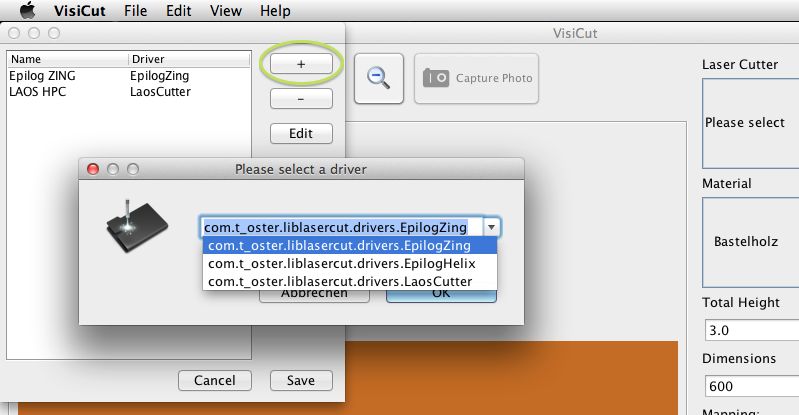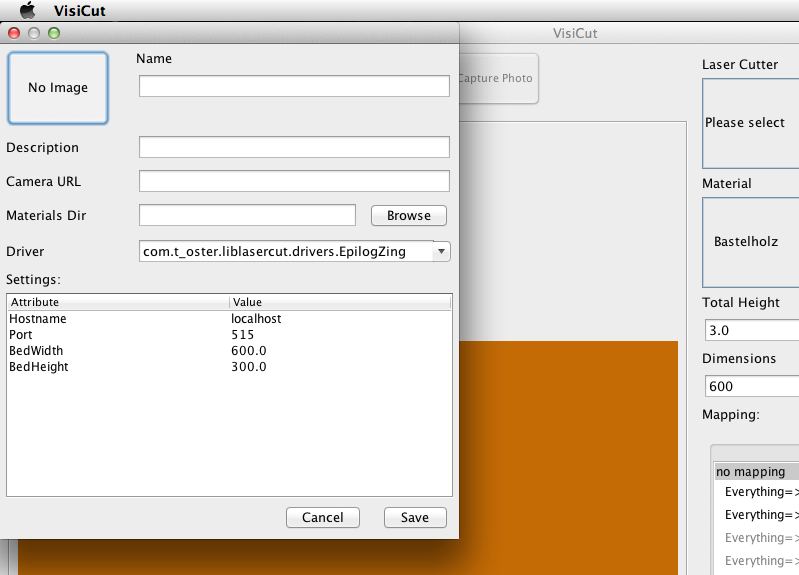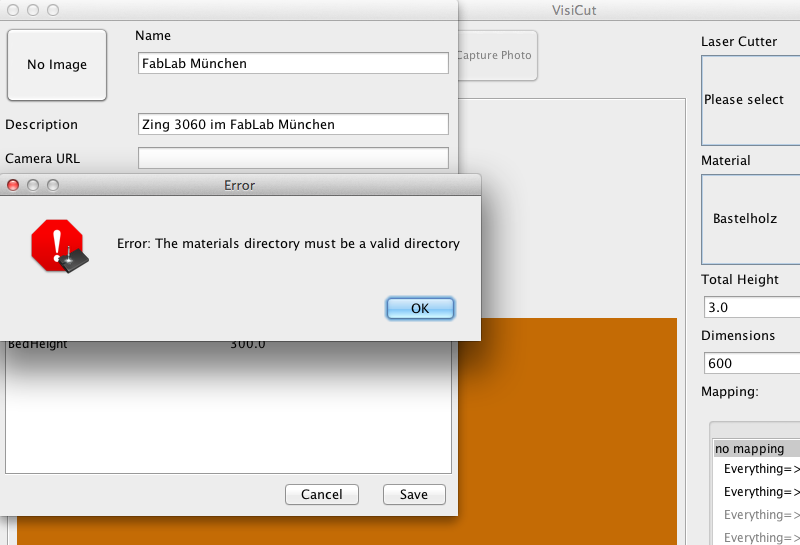Von Mac via VisiCut auf Zing 3060
Diese Dokumentation ist seit dem Erscheinen von VisiCut 1.4 veraltet.
Hier geht es zur Dokumentation für VisiCut 1.4.
Diese Dokumentation basiert auf:
- Mac OS X 10.7.2 (Lion)
- VisiCut 1.3.2
Wir sind noch im "Jugend forscht"-Modus. Die Dokumentation illustriert unser derzeitiges Wissen.
Installation
- Download von VisiCut unter https://amedeo.informatik.rwth-aachen.de/groups/visicut/
- Entpacke die Datei VisiCutMac-1.3.2.zip
- Ziehe die Application "VisiCut" in den Programme Folder.
- Starte die Application "VisiCut".
Konfiguration (Einrichten des Zing 3060)
- Gehe zu Edit > Advanced > Manage LaserCutters.
- Füge einen neuen Lasercutter durch Klick auf den
Button hinzu.
- Wähle com.t_oster.liblasercut.drivers.EpilogZing als Treiber
- Dieser Dialog erscheint.
- Im Feld Name trage einen Namen ein, z.B. "FabLab München"
- Im Bereich Setting Doppelklick in der Zeile Hostname auf localhost)
- Trage 192.168.2.222 ein (das ist die IP des Zing 3060 im FabLab München)
- Klicke auf "Save".
- Autsch. Das Feld Materials Dir ist ein Pflichtfeld! VisiCut hat uns das nicht gesagt.
- Trage folgenden Pfad in Materials Dir ein: /Applications/VisiCut.app/Contents/Resources/Java/settings/VisiCut-MaterialDB/EpilogZING
Wir müssen noch einen Weg finden, wir wir ein Materials XML für das gesamte FabLab haben können.
- TODO: Prüfen, was wir hier eingeben können.
- Einen lokalen Pfad zu benutzen (z.B. /Users/mgeck/Dropbox/FabLab/VisiCut_Material) führt zur Meldung "Material not supported" im LaserCutter Drop-Down dialog. Vermutlich muss man erst ein Materials XML durch Edit > Advanced > Manage Materials... anlegen.
Wäre schön, wenn gleich ein Template angelegt worden wäre.
- Jetzt ist der FabLab München Lasercutter in der "Laser Cutter" Liste verfügbar.
Lasern
- Ok, der Laser scheint konfiguriert zu sein.
- Wir laden ein in Adobe Illustrator erstelltes SVG.
- Wir wählen das Material.
Achtung: Man muß am Anfang den Focus auf die Höhe des Gitters einstellen - dann wird vom Programm der Abstand automatisch auf die gewählte Materialhöhe korrigiert. Das erspart das Kalibrieren / Fokusieren (Set Focus), vorausgesetzt man nutzt kein CorelDraw mehr, denn Anwender, die CorelDraw benutzen, würden die Fokuseben wieder verstellen.
- Wir klicken auf "Execute".
- Der Lasercutter nimmt den Job an. Ein Testlauf mit dem roten Laser (also ohne zu schneiden) sieht gut aus.
- Wir wagen einen ersten Schnitt.
Fazit
- Die Grundfunktionalität der Oberfläche ist sehr gut gestaltet. VisiCut ist einfach genug, um für FabLab Kids: Info für die Kursleiter eingesetzt werden zu können.
- VisiCut würde im FabLab München mehrere Probleme beheben:
- aktuell ist der LaserCutter-PC mit CorelDraw der Flaschenhals, nicht der Laser selbst. Wenn jeder selbst Jobs schicken kann, würde der LaserCutter effektiver genutzt werden können.
- aktuell muss man immer über den Windows-PC gehen. Mit VisiCut konnten wir jetzt auch einen Job von einem Mac schicken (Linux noch nicht getestet).
User Stories
Folgende Rollen gibt es bei uns:
- FabLab admin
- hat viel Erfahrung mit Software-Konfiguration.
- weiss, wo er Informationen zu unserem IT-System finden kann.
- hat ein mentales Modell davon, wie die einzelnen Geräte zusammenhängen.
- FabLab user
- kann Erfahrung mit Software-Konfiguration haben, muss aber nicht.
- Möchte sich mit den IT-Systemen nicht herumschlagen müssen, sondern die Systeme nutzen.
- Hat keine Vorstellung davon, wie Router, Lasercutter und Software zusammenhängen.
Die Umsetzung folgender Epics & User Stories wünschen wir uns (priorisiert):
Theme: Central Configuration for all FabLab users.
Epic: As a FabLab admin I want to provide a central library of materials to FabLab user so that FabLab users do not have to configure their own material libraries, but could benefit from the shared knowledge on materials.
- As a FabLab admin I want to understand how I can reuse the library I created in the Epilog driver so that I can save time and effort on getting all the materials data into VisiCut.
- As a FabLab admin I want to understand what the best-practice is for storing the material library on a central storage location so that I can set it up.
- Given that FabLab users are using Linux, Mac and Windows laptops.
- Given that FabLab users do not know how to mount a network drive - If you know how to do that consider yourself a FabLab admin.
- Given that FabLab users do not remember their passwords for shares.
Epic: As a FabLab admin I want to have an easy way to deploy the configuration to all FabLab users so that FabLab users woud not have to set up the VisiCut configuration manually.
- Ideally:
- As a FabLab admin I want to be able to provide an installer / application that includes all configuration data so that FabLab users would not have to worry about setting up the system (Best practice: Cisco AnyConnect VPN Client. Users do not have to care about any configuration but just load and start the application)
- Good enough:
- As a FabLab admin I want to have a VisiCut configuration file that users can load so that I can point them to the configuration file.
Theme: Positioning my work.
- As a FabLab user I want to be able to rotate my SVG so that I don't have to go back to my drawing application, rotate, save, open again.
Theme: Localization.
- As a FabLab user speaking German - but little English - I want to have a localized version of VisiCut so that I don't feel stupid when using the application.
- As a FabLab admin I want to know how I can contribute to the localization effort so that I can help localizing VisiCut.






